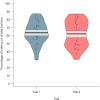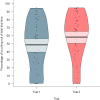Emotional Movement Kinematics Guide Twelve-Month-Olds' Visual, but Not Manual, Exploration
- PMID: 39841055
- PMCID: PMC11753196
- DOI: 10.1111/infa.70000
Emotional Movement Kinematics Guide Twelve-Month-Olds' Visual, but Not Manual, Exploration
Abstract
The ability to recognize and act on others' emotions is crucial for navigating social interactions successfully and learning about the world. One way in which others' emotions are observable is through their movement kinematics. Movement information is available even at a distance or when an individual's face is not visible. Infants have been shown to be sensitive to emotions in movement kinematics of transporting actions, like moving an object from one to another place. However, it is still unknown whether they associate the manipulated object with the emotions contained in moving it, and whether they use this information to guide their own exploration of this object. In this study, 12-month-old infants watched actors transporting two toys with positive or negative emotional valence. Then, infants were given the possibility to interact with the same toys. We expected the infants to look at and touch the toy handled in a positive manner more, compared to the toy handled in a negative manner. Our results showed that infants looked at the positive toys more than at the negative toys, but that infants touched both toys for the same amount of time. Also, there was no difference in which toy they manually explored first.
Keywords: emotion; emotion processing; exploration; kinematics; movement.
© 2025 The Author(s). Infancy published by Wiley Periodicals LLC on behalf of International Congress of Infant Studies.
Conflict of interest statement
The authors declare no conflicts of interest.
Figures









Similar articles
-
Differential effects of others' emotional cues on 18-month-olds' preferential reproduction of observed actions.Infant Behav Dev. 2018 May;51:60-70. doi: 10.1016/j.infbeh.2018.04.002. Epub 2018 Apr 19. Infant Behav Dev. 2018. PMID: 29679813
-
It's the journey, not the destination: Locomotor exploration in infants.Dev Sci. 2019 Mar;22(2):e12740. doi: 10.1111/desc.12740. Epub 2018 Oct 8. Dev Sci. 2019. PMID: 30176103 Free PMC article.
-
Infants' use of contextual cues in the generalization of effective actions from imitation.J Exp Child Psychol. 2013 Oct;116(2):510-31. doi: 10.1016/j.jecp.2012.09.013. Epub 2013 Jan 26. J Exp Child Psychol. 2013. PMID: 23357091
-
Infants' ability to draw inferences about nonobvious object properties: evidence from exploratory play.Child Dev. 1993 Jun;64(3):711-28. Child Dev. 1993. PMID: 8339691
-
The developmental origins of naïve psychology in infancy.Adv Child Dev Behav. 2009;37:55-104. doi: 10.1016/s0065-2407(09)03702-1. Adv Child Dev Behav. 2009. PMID: 19673160 Review.
References
-
- Brosseau‐Liard, P. E. , and Poulin‐Dubois D.. 2014. “Sensitivity to Confidence Cues Increases During the Second Year of Life.” Infancy 19, no. 5: 461–475. 10.1111/infa.12056. - DOI
MeSH terms
Grants and funding
LinkOut - more resources
Full Text Sources
Medical

